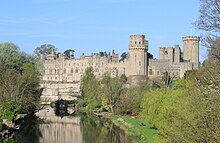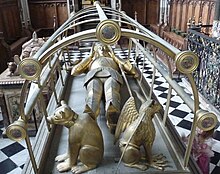Richard Beauchamp, 13th Earl of Warwick
Richard Beauchamp, 13th Earl of Warwick (born January 25 or 28, 1382 Salwarpe Court ; † April 30, 1439 in Rouen ) was an English nobleman and military man.
Life
Richard Beauchamp was the son of Thomas Beauchamp, 12th Earl of Warwick , and Margaret Ferrers, daughter of William Ferrers, 3rd Baron Ferrers of Groby . King Richard II was his godfather. He was knighted on the occasion of the coronation of Henry IV on October 13, 1399 and succeeded his father as Earl of Warwick on April 8, 1401 .
Shortly after coming of age and assuming responsibility in his earldom, he took part in the campaign against the rebellion of Owain Glyndŵr in Wales . On July 22, 1403, the day after the Battle of Shrewsbury , he was inducted into the Order of the Garter ( Knight of the Garter , KG). In the summer of 1404 he invaded what is now Monmouthshire at the head of an English force . At the Battle of Mynydd Cwmdu near Tretower Castle , he put the Welsh to flight, almost succeeding in capturing Owain Glyndŵr. The Welsh fled down the valley of the River Usk but were able to regroup and then await the pursuing English forces in an ambush. After a skirmish on Craig-y-Dorth, a conical hill near Cwmcarvan , the English now pursued them as far as the city walls of Monmouth .
Warwick gained a reputation as a knight when he made a pilgrimage to the Holy Land in 1408 , where he was asked many times to compete in demonstration fights that were popular at the time. He traveled back via Russia and Eastern Europe, in 1410 he tried to join the Teutonic Order after the Battle of Tannenberg , but then returned to England, which he reached later in the same year.
In 1410 he was appointed a member of the Curia Regis ( Royal Council ), two years later he was commander in the battle for Calais . Until then, Warwick's career was that of a knight errant, but at the coronation of Henry V on April 9, 1413, he officiated as Lord High Steward and then became one of the king's confidants. 1414 he participated in the suppression of the Lollards -Aufstands part and then went as captain of Calais mainland. On November 8, 1414, he represented England at the coronation of Sigismund of Bohemia as Roman-German King in Aachen and then at the Council of Constance , which began on November 5, 1414.
Warwick spent much of the next decade fighting the Hundred Years War in France. He played a significant role in the campaigns of 1417 and 1418 and joined Henry V before the siege of Rouen (July 1418 to January 1419). In October 1418 he was entrusted with the negotiations with the French Dauphin Karl and Duke Johann without fear of Burgundy. During the negotiations in Meulan (May 29 to June 30, 1419), the spokesman for the English delegation, followed by Henry V's agent, was in the negotiations for the Treaty of Troyes , which was signed on May 20, 1420. Until 1422 he then fought mainly in the siege of French fortresses.
In 1419, as part of Henry V's policy to endow his nobles with Norman titles, he was appointed (English) Count of Aumale in the Peerage of England (for life, but not hereditary). In addition, he became master of the horse .
In his will, Henry V Warwick assigned responsibility for the upbringing of the heir to the throne and later King Henry VI. (* December 6, 1421). This task obliged him to travel numerous times between England and Normandy.
In 1431 he was the English superintendent at the trial of Joan of Arc . When in 1437 Henry VI. came of age, the royal council considered Warwick's duty fulfilled. Despite his age (he was 55 at the time) he accepted his appointment as Lieutenant of France and Normandy ; he reached Normandy on November 8th and stayed in France for the remaining two years of his life. Before leaving England he had made his will at Caversham Castle ; he died on April 30, 1439 in Rouen. In 1475 he found his final resting place in the Collegiate Church of St Mary in Warwick , after the construction had been completed according to the provisions of the will.
marriage and family
Richard Beauchamp married before October 5, 1397 Elizabeth Berkeley (* around 1386, † December 28, 1422), daughter of Thomas de Berkeley, 5th Baron Berkeley and Margaret de Lisle, 3rd Baroness Lisle ; from this marriage he had three daughters:
- Margaret Beauchamp (1404 - June 14, 1467); ∞ September 6, 1425 John Talbot, 1st Earl of Shrewsbury (* around 1387, † July 17, 1453), whose descendant John Dudley was named Earl of Warwick and later Duke of Northumberland .
- Eleanor Beauchamp (September 1408 - March 6, 1467); ∞ (1) December 17, 1423 Thomas de Ros, 8th Baron de Ros (born September 26, 1406 - † August 18, 1430); ∞ (2) 1431/33 Edmund Beaufort, 2nd Duke of Somerset (* around 1406 - † May 22, 1455).
- Elizabeth Beauchamp (* 1417; † 1480); ∞ (1) George Nevill, 1st Baron Latymer (* around 1407; † December 30/31, 1469); ∞ (2) Thomas VI. Wake of Blisworth (1435--1476).
In his second marriage he married Isabel le Despenser, 5th Baroness Burghersh (born July 26, 1400; † 1439), daughter of Thomas le Despenser, 1st Earl of Gloucester and Constance Langley; his children from this marriage are:
- Henry Beauchamp (March 21, 1425, † June 11, 1446), who followed his father as the 14th Earl of Warwick and was later named Duke of Warwick.
- Anne Beauchamp (September 1426; † 1492), 16th Countess of Warwick; ∞ Richard Neville, 16th Earl of Warwick (born November 22, 1428 - April 14, 1471), called "the kingmaker"
literature
- Richard Gough , Description of the Beauchamp chapel, adjoining to the church of St. Mary, at Warwick. And the monuments of the earls of Warwick, in the said church and elsewhere , Warwick Town, St Mary, 1803
- James Gairdner, Beauchamo, Richard de, Earl of Warwick (1382–1439) , in: Leslie Stephen (ed.), Dictionary of National Biography , 4, London, Smith, Elder & Co.
- Hugh Chisholm (Ed.), Warwick, Richard Beauchamp, Earl of , in: Encyclopædia Britannica , 11th Edition, Volume 28, Cambridge University Press
- Christine Carpenter, Beauchamp, Richard, thirteenth earl of Warwick (1392-1439) , in: Oxford Dictionary of National Biography , 2004
- John Ashdown-Hill, Eleanor the Secret Queen , The History Press, 2009, ISBN 978-0-7524-5669-0
Richard Beauchamp in literature
Richard Beauchamp is the Earl of Warwick who appeared in William Shakespeare's plays Henry V and Henry VI. , 1st part, occurs; the Earl of Warwick of the 2nd and 3rd part, however, is his son-in-law, the kingmaker Richard Neville.
He is also the Earl of Warwick, who appears in George Bernard Shaw's drama Saint Joan and Jean Anouilh's drama Jeanne or The Lark .
Remarks
- ↑ a b Carpenter
- ↑ a b Gough, p. 17
- ↑ Ashdown-Hill, p. 23.
- ^ Ian Mortimer, Henry IV: The Self-made King
- ^ Richard Barber, The knight and chivalry
- ↑ a b c d e Encyclopædia Britannica , p. 339
- ↑ Ashdown-Hill, p. 24
| personal data | |
|---|---|
| SURNAME | Richard Beauchamp, 13th Earl of Warwick |
| ALTERNATIVE NAMES | Count of Aumale |
| BRIEF DESCRIPTION | English nobleman and military |
| DATE OF BIRTH | January 25, 1382 or January 28, 1382 |
| PLACE OF BIRTH | Salwarpe Court |
| DATE OF DEATH | April 30, 1439 |
| Place of death | Rouen |



